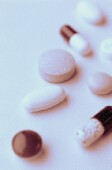No increase in use for those aged 1 to 12 years; males more likely to use antipsychotics than females
THURSDAY, July 2, 2015 (HealthDay News) — From 2006 to 2010 there was an increase in antipsychotic medication use among adolescents and young adults, according to a study published online July 1 in JAMA Psychiatry.
Mark Olfson, M.D., M.P.H., from Columbia University in New York City, and colleagues conducted a retrospective descriptive analysis of antipsychotic prescriptions among patients aged 1 to 24 years using data from 2006, 2008, 2010, and a subset from 2009 with service claims data.
The researchers found that in 2006 and 2010 the percentages of young people using antipsychotics were 0.14 and 0.11 percent, respectively, for younger children (1 to 6 years); 0.85 and 0.80 percent for older children (7 to 12 years); 1.10 and 1.19 percent for adolescents (13 to 18 years); and 0.69 and 0.84 percent for young adults (19 to 24 years). Males were more likely to use antipsychotics than females in 2010, particularly during childhood and adolescence. Among those treated with antipsychotics in 2010, younger children were less likely to receive a prescription from a psychiatrist than other age groups (57.9 versus 70.4 to 77.9 percent). Among those with claims for mental disorders treated with antipsychotics, attention-deficit/hyperactivity disorder was the most common diagnosis in younger and older children and adolescents, and depression was the most common diagnosis in young adults.
“Peak antipsychotic use in adolescence, especially among boys, and clinical diagnosis patterns are consistent with management of developmentally limited impulsive and aggressive behaviors rather than psychotic symptoms,” the authors write.
Copyright © 2015 HealthDay. All rights reserved.








